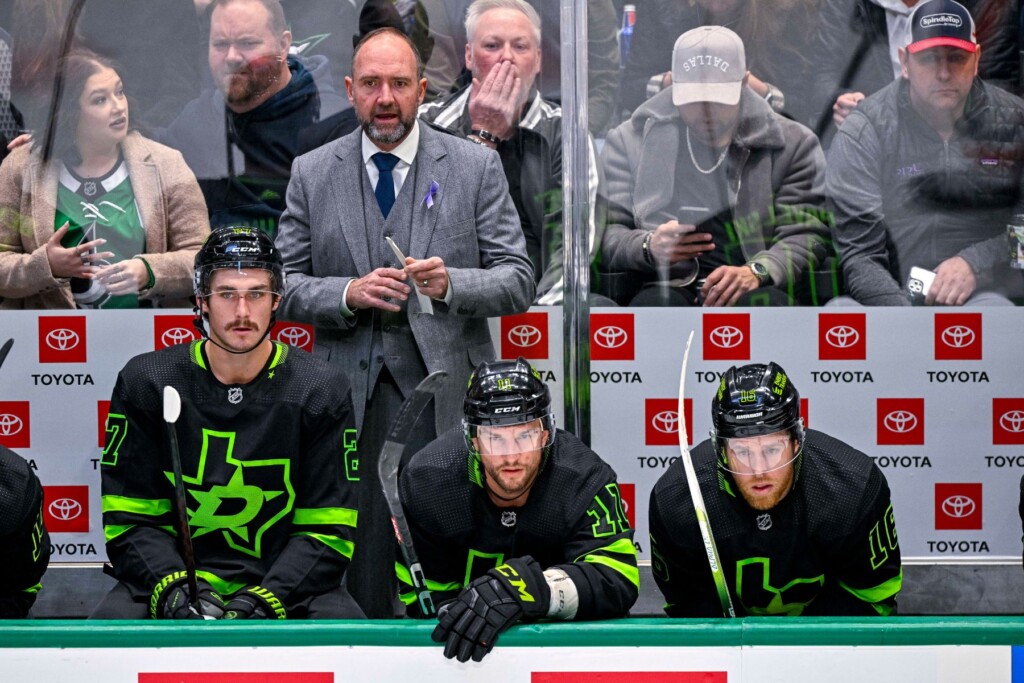For a team that has been run by relatively steady leadership for the past decade, the Stars have experienced a lot of fluctuation during Jim Nill’s 11-year tenure.
There were the run-and-gun Lindy Ruff days of Tyler Seguin and Jamie Benn’s youth, which came to a halt with the Great Ken Hitchcock Reset. Then came the lofty promises of Jim Montgomery and Miro Heiskanen, followed by Rick Bowness’s COVID Cup Run and pivot to defense, which ended in Jake Oettinger’s valiant performance under siege in 2022.
But whether leading with offense or defense, operating out of caution or killer instinct, the Stars have always been at their best when they are unapologetic about their identity. They had a legendary offensive season in 2015-16, followed by two later playoff runs where the goalie was the main story. We can debate the merits of different approaches at different times, but what isn’t up for debate is this: the Stars are a very good hockey team, this year, right now.
That fact is hard to remember when Oettinger isn’t in net, and even harder to believe when Heiskanen misses time. At their best, the Stars are a fortress bristling with cannons, but at the moment, they can feel more like a precarious Jenga tower short two foundational blocks. Things have gotten dicey lately, even after the warm feeling that bludgeoning Minnesota a couple of times will bring.
Or perhaps it would be more accurate to say that things have felt dicey. Because even though the Bowness-led Winnipeg Jets have rocketed to the top of the standings, and even after Dallas has experienced prolonged struggles for the first real time this year, the Stars are still built to compete for the top spot in the Western Conference and are projected to be right there. Scott Wedgewood has done an admirable job filling in for Oettinger—he hasn’t stolen many games, but he has managed not to lose many, either. And for all of DeBoer’s concern about not putting too much responsibility on Thomas Harley too soon, the 22-year-old has stepped up admirably to fill the void atop the blue line, as many predicted he would.
DeBoer’s Stars are resilient, even if they’re flawed, but they don’t always seem to realize how sturdily they’re built. The sheer magnitude of replacing Heiskanen to begin with—being asked to play the full two minutes of power plays right before his unfortunate injury while also playing the fifth-most minutes in the NHL felt a little too on the nose—has been a sobering reminder of just how much Dallas has leaned on very few players. Even when the season has gone well, the coaching staff often tends to narrow its focus rather than spreading around the burden of 82 games. And when one of those key players goes missing, everything seems to get tense in a hurry.
Vegas won a Stanley Cup last year by consistently rolling four forward lines backed by a deep defense corps and shockingly elite goaltending. It was a fever dream of a roster. Nill is never going to be as brutally efficient as Kelly McCrimmon when it comes to ripping apart a roster and stitching it back together, but the Stars still could stand to let other players share the important loads so that the absence of one key cog doesn’t send all the gears out of whack at the worst possible time. If John Klingberg could get thrown into a frantic 2014 season and immediately take over top-pairing duties, then a more-seasoned Harley is plenty capable of playing a few extra minutes on a far more complete hockey team a decade later. Responsibility is a danger if it’s misplaced, but it’s ennobling when it finds its mark.
When a team is winning, coaches tend to be reluctant to mess with the lineup. But to paraphrase the old canard, refusing to make changes because you won the last game is tantamount to admitting you don’t know why you won. The Stars had a very good season last year, but rather than conducting major surgery on the defense, Nill added Matt Duchene and some other role players. Now that they’re facing more adversity, the need to adapt is undeniable. Nevertheless, Dallas has been relatively slow to make adjustments, presumably for fear of undoing the many things that have gone very right this year.
But that’s the whole reason teams hope for solid, above-average regular seasons: a margin for error, or at least for experimentation. Dallas is extremely likely to make the playoffs, and playing a third-string goalie such as Matt Murray here and there to keep Wedgewood fresh is not going to change that. For that matter, neither would letting Nils Lundkvist try to figure out the same old things for another few games. Ty Dellandrea has shown the ability to spell Radek Faksa and even Evgenii Dadonov at times, and things haven’t come crashing down because Duchene has taken some of Jason Robertson’s minutes here and there. Dallas can afford to hold auditions for some of its leading roles as well as its supporting cast. The two outstanding forwards down in Cedar Park also seem like prime candidates to bolster the edges of the roster, much like Harley did last spring; however, there is no sign yet that Dallas wants to throw Logan Stankoven or Mavrik Bourque into NHL action.
The reluctance to trust the next man up seems rooted in fear the Stars shouldn’t have. Their forward depth is the envy of most of the league, and they’ve shown they can pile up points in the standings without elite goaltending. The defense needs some help, but Dallas has time to solve that, internally or otherwise. Frankly, it’s impressive how far the Stars have gotten in recent seasons despite the warts on the blue line.
Coaches are paid to win the game in front of them, which is why the coaching staff and front office have to moderate each other’s priorities in order to do what’s best for the team. Failing to trust your depth for fear of losing a game here and there not only wears out the top players; it also places way more pressure on younger players when they finally do get a chance to fill those roles, because the implicit message is that all that matters is winning the next game. That’s a great mentality for a player to have when hopping over the boards, but it can be limiting when it permeates your roster construction or lineup choices. The season is too long not to plan for ebbs and flows.
It sounds almost profligate, but the Stars are good enough this year that they need to be willing to “punt” on games—or at least not go all-out in terms of lineup choice—every once in a while. Even your third-string goalie or seventh defenseman can surprise you, and not resting your most trusted players will set them up for fatigue when the pressure ratchets up in the spring. The idea of not giving everything to win every game seems anathema, but the reality is that coaches know load management is needed, even if they can’t say it. There is a reason backup goalies exist, after all.
Even the areas that are working well have been a victim of their own success. Jani Hakanpää and Esa Lindell have consistently soaked up 80 percent of the penalty-kill minutes, and to their credit, the Stars have indeed killed a great majority of those. But that also wears them down for 5v5 play, which puts a greater strain on the other players to soak up more 5v5 minutes. It also sets up Dallas for potential panic again if one of Lindell or Hakanpää isn’t available, which is exactly what happened in the playoffs last year when Hakanpää missed time against Vegas. Unsurprisingly, DeBoer had Heiskanen killing all of a two-minute penalty alongside Lindell in the first game of the series, in a game the Stars lost in overtime. Even elite players like Heiskanen could benefit from some rest, if you’re willing to trust (or at least try out) more than a handful of players for special teams roles.
To DeBoer’s credit, he has shown a willingness to mix things up when it comes to the forward lines, even with the formerly vaunted Robertson-Roope Hintz-Joe Pavelski trio. Vegas demonstrated last spring how hard it is to match up against a team that trusts its depth and comes at you in flurries rather than trying to set you up for their biggest weapons to always deliver the knockout punch. DeBoer’s staff have been quick to hand lots of responsibility to Seguin, Duchene, and even Mason Marchment, and the trio has justified that trust at every turn.
DeBoer has also experimented with less traditional things including all-forward setups, both in 3v3 overtime and the 5v4 power play, albeit with mixed success. That leads one to believe the Stars’ heavy reliance on smaller groups of players in certain situations isn’t a matter of preference as much as the perceived risks of the alternatives. While top players tend to be able to handle minutes in any form, there is a danger in disrupting a player’s rhythm when he doesn’t know what to expect from shift to shift.
Navigating a regular season is difficult enough on its own, but it’s an even trickier balance to strike given the looming specter of high playoff expectations. How the Stars finish their playoff run this year will most likely be determined by the choices they make during the second half of the regular season. Those choices should be made with confidence in this team’s ceiling rather than fear of its floor.
Author







